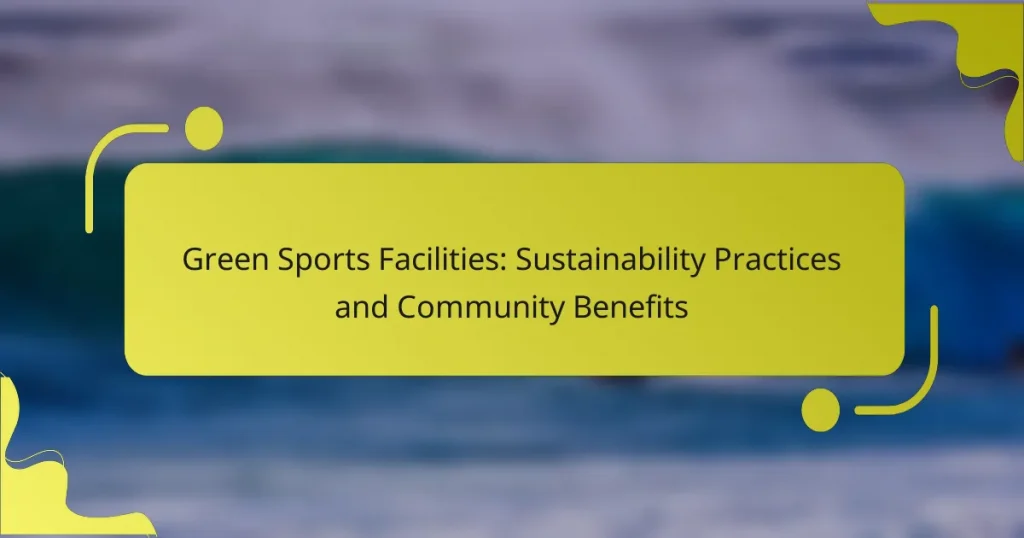Green sports facilities offer significant community benefits through sustainability practices. They incorporate energy-efficient designs and water conservation systems while using sustainable materials. These facilities enhance public health and promote eco-friendly behaviors. Engaging with local stakeholders further strengthens community ties and fosters environmental awareness.

What are the key sustainability practices in green sports facilities?
Green sports facilities implement key sustainability practices that enhance environmental responsibility and community engagement. These practices include energy-efficient designs, water conservation systems, and the use of sustainable materials.
Energy-efficient designs optimize resource use, reducing operational costs. Facilities often incorporate renewable energy sources, such as solar panels, to decrease carbon footprints. Water conservation systems, including rainwater harvesting and low-flow fixtures, minimize water waste. Sustainable materials, like recycled or locally sourced products, lower environmental impact during construction and maintenance.
Additionally, green sports facilities promote community benefits by enhancing public health and encouraging eco-friendly behaviors. They serve as educational platforms, raising awareness about sustainability issues. These initiatives foster a sense of community pride and engagement, contributing to overall societal well-being.
How do renewable energy sources impact facility operations?
Renewable energy sources significantly enhance facility operations by reducing operational costs and environmental impact. They promote energy efficiency and sustainability in green sports facilities. For instance, solar panels can lower electricity expenses while wind turbines contribute to energy independence. Facilities utilizing renewable energy often experience improved community perception and engagement, fostering a positive local image. Additionally, these practices can lead to unique attributes, such as LEED certification, which distinguishes facilities committed to sustainability.
Which water conservation techniques are commonly implemented?
Common water conservation techniques include rainwater harvesting, greywater recycling, xeriscaping, and efficient irrigation systems. These practices enhance sustainability in green sports facilities and support community water management efforts.
Rainwater harvesting captures and stores rain for irrigation and facility use. Greywater recycling repurposes wastewater from sinks and showers for landscaping. Xeriscaping uses drought-resistant plants to reduce water needs. Efficient irrigation systems minimize water waste through smart technologies.
What materials are preferred for sustainable construction?
Sustainable construction often prioritizes materials that minimize environmental impact. Preferred materials include recycled steel, bamboo, reclaimed wood, and low-VOC (volatile organic compounds) paints. These choices enhance energy efficiency and reduce carbon footprints. Additionally, utilizing local materials can further support community economies and sustainability efforts.

How do green sports facilities benefit local communities?
Green sports facilities benefit local communities by promoting environmental sustainability, enhancing public health, and fostering social cohesion. These facilities often incorporate renewable energy sources, reducing carbon footprints. They provide green spaces that encourage physical activity, improving community health. Additionally, such facilities can serve as venues for community events, strengthening local ties.
What social impacts arise from sustainable sports venues?
Sustainable sports venues foster social impacts by enhancing community engagement, promoting health, and supporting local economies. These facilities often serve as hubs for environmental education and social interaction.
Green sports facilities encourage community participation through events and programs, building a sense of belonging. They also promote physical activity, contributing to improved public health outcomes. Furthermore, sustainable practices attract eco-conscious visitors, boosting local businesses and creating jobs.
By prioritizing sustainability, these venues can lead to a culture of environmental responsibility within the community. Such initiatives often inspire residents to adopt greener practices, fostering a long-term commitment to sustainability.
Overall, the social impacts of sustainable sports venues extend beyond athletics, enriching community life and promoting a healthier, more engaged population.
How do these facilities promote health and wellness?
Green sports facilities promote health and wellness through sustainable practices that enhance community engagement and physical activity. They often incorporate green spaces, which improve air quality and provide areas for exercise. Facilities with energy-efficient designs reduce environmental impact, fostering a healthier planet. Programs that encourage local participation in sports and wellness activities strengthen community ties, promoting mental well-being. Additionally, access to nature and recreational opportunities contributes to overall physical health, making these facilities vital for community wellness.
Which economic advantages do they provide to the community?
Green sports facilities provide significant economic advantages to the community, including job creation, increased local revenue, and enhanced property values. These facilities often attract events that generate tourism, leading to higher spending in local businesses. For example, hosting sports tournaments can increase hotel occupancy and restaurant patronage. Additionally, sustainable practices reduce operational costs, allowing funds to be redirected into community programs. Overall, green sports facilities foster a vibrant economy while promoting environmental stewardship.

What role do certifications play in establishing green sports facilities?
Certifications play a crucial role in establishing green sports facilities by ensuring adherence to sustainability standards. They provide a framework for evaluating environmental performance and promote best practices in resource management. Certifications like LEED and BREEAM enhance credibility, attract funding, and foster community trust. Facilities with recognized certifications often report improved energy efficiency and reduced operational costs, benefiting both the environment and the local community.
Which organizations provide accreditation for sustainability standards?
Several organizations provide accreditation for sustainability standards in green sports facilities. Notable accrediting bodies include the U.S. Green Building Council (LEED certification), the International Organization for Standardization (ISO 14001 for environmental management), and the Global Sustainability Assessment System (GSAS). These organizations establish criteria that promote environmentally responsible practices, enhancing community benefits and facility performance.
How do certifications influence public perception and usage?
Certifications significantly enhance public perception and usage of green sports facilities. They signal commitment to sustainability, attracting eco-conscious visitors and sponsors. Certified facilities often report increased attendance and community support, reinforcing their reputation as leaders in environmental responsibility. For example, LEED-certified venues frequently experience higher engagement rates, demonstrating the value of recognized sustainability practices.

What innovative technologies are being used in green sports facilities?
Innovative technologies in green sports facilities include solar panels, rainwater harvesting systems, energy-efficient lighting, and sustainable materials. These advancements enhance sustainability and reduce carbon footprints. For example, solar panels can significantly decrease energy costs while promoting renewable energy use. Rainwater harvesting systems provide irrigation, minimizing water waste. Energy-efficient lighting improves visibility and reduces electricity consumption. Sustainable materials, such as recycled plastics and bamboo, contribute to eco-friendly construction practices. These technologies collectively foster community benefits by promoting environmental awareness and encouraging healthier lifestyles.
How does smart technology enhance energy efficiency?
Smart technology significantly enhances energy efficiency in green sports facilities by optimizing resource use. Smart systems monitor energy consumption in real time, allowing facilities to adjust usage patterns based on demand. For example, automated lighting systems reduce energy waste by adjusting brightness based on occupancy. Additionally, smart HVAC systems improve climate control, ensuring optimal conditions while minimizing energy expenditure. These technologies contribute to lower operational costs and reduced carbon footprints, aligning with sustainability practices that benefit both the environment and the community.
Which examples showcase cutting-edge sustainable design?
Green sports facilities exemplify cutting-edge sustainable design through innovative practices that enhance community benefits. Notable examples include the Levi’s Stadium in California, which features a solar power system generating 1.2 MW, and the Amway Center in Florida, utilizing a rainwater harvesting system that saves over 1 million gallons annually. Additionally, the Mercedes-Benz Stadium in Atlanta incorporates a green roof and energy-efficient systems, showcasing a commitment to sustainability. These facilities not only reduce environmental impact but also promote community engagement and awareness of sustainable practices.

How do green sports facilities engage with stakeholders?
Green sports facilities engage with stakeholders by fostering collaboration, promoting sustainability, and enhancing community involvement. They involve local governments, environmental organizations, and community groups in decision-making processes. This engagement ensures alignment with community values and sustainability goals.
For example, green sports facilities often host workshops and outreach programs to educate stakeholders about environmental practices. They also seek feedback from local residents to improve facility designs and operations. As a result, these facilities build strong relationships and create shared benefits for the community.
Engagement metrics show that facilities with active stakeholder involvement report higher satisfaction rates among users. This collaborative approach not only enhances the facility’s reputation but also contributes to the overall health of the community.
What partnerships are essential for successful sustainability initiatives?
Successful sustainability initiatives in green sports facilities rely on partnerships with local governments, environmental organizations, and community stakeholders. These collaborations enhance resource sharing, promote best practices, and increase community engagement. For example, partnerships with local governments can facilitate access to funding and regulatory support, while working with environmental organizations can provide expertise in sustainable practices. Engaging community stakeholders ensures that initiatives align with local needs and values, fostering greater support and participation.
How can community feedback shape facility operations?
Community feedback significantly influences facility operations by aligning them with user needs. Engaging local stakeholders fosters sustainable practices and enhances community benefits. Feedback can identify areas for improvement, such as energy efficiency and waste management strategies. This input helps facilities adapt to changing community preferences, ensuring they remain relevant and effective. Moreover, incorporating suggestions leads to increased community ownership and support for sustainability initiatives.

What are the challenges faced by green sports facilities?
Green sports facilities face challenges such as high initial costs, maintenance complexities, and community engagement hurdles. These facilities often require significant investment in sustainable technologies, which can deter funding. Maintenance of eco-friendly systems, like solar panels and rainwater harvesting, can also be more complex than traditional methods. Additionally, engaging the community to support and utilize these facilities presents a unique challenge, as awareness and education are essential for maximizing their benefits.
How do financial constraints impact sustainability efforts?
Financial constraints significantly hinder sustainability efforts in green sports facilities. Limited budgets restrict investments in eco-friendly technologies and materials. Facilities may prioritize immediate financial returns over long-term sustainability goals. As a result, many projects adopt minimal compliance with regulations rather than innovative practices. This compromise can diminish community benefits and environmental impact.
Which regulatory hurdles must be navigated for compliance?
Navigating regulatory hurdles for compliance in green sports facilities involves adhering to environmental laws, building codes, and sustainability certifications. Key regulations include local zoning laws, waste management standards, and energy efficiency mandates. Facilities must also comply with health and safety regulations, ensuring safe environments for athletes and spectators. Engaging with community stakeholders can facilitate smoother compliance processes and enhance community benefits.

What unique attributes distinguish notable green sports facilities?
Notable green sports facilities are distinguished by their innovative sustainability practices, community engagement, and unique design features. These facilities often incorporate renewable energy sources, such as solar panels, which reduce carbon footprints significantly. Water conservation systems, including rainwater harvesting, enhance their environmental responsibility. Additionally, they promote local biodiversity through landscaping that supports native species. Furthermore, community-focused initiatives, like accessible green spaces and educational programs, foster a strong connection with local populations. These attributes collectively set these facilities apart in the realm of sustainable architecture.
What rare features enhance the visitor experience?
Green sports facilities enhance visitor experience through unique features like natural landscaping, renewable energy sources, and eco-friendly materials. These elements create a welcoming atmosphere while promoting sustainability. For example, facilities that integrate biophilic design improve mental well-being and encourage longer stays. Additionally, providing educational programs on environmental stewardship fosters community engagement and awareness.
How do specific design elements reflect local culture?
Specific design elements in green sports facilities often mirror local culture through materials, aesthetics, and community engagement. For instance, using locally sourced materials reflects regional craftsmanship and sustainability values. Architectural styles may incorporate traditional designs, enhancing cultural identity. Community involvement in facility planning fosters a sense of ownership and pride, aligning with local traditions. Additionally, environmental features, such as native landscaping, promote ecological awareness, resonating with community values. These elements collectively create spaces that honor and reflect the unique cultural fabric of the area.
What are the most recognized green sports facilities globally?
The most recognized green sports facilities globally include the Mercedes-Benz Stadium, the Barclays Center, and the Levi’s Stadium. These venues showcase advanced sustainability practices that enhance community benefits.
Mercedes-Benz Stadium in Atlanta, Georgia, features a rainwater harvesting system and a solar power installation, reducing its environmental impact. The Barclays Center in Brooklyn, New York, utilizes energy-efficient lighting and has a green roof that supports local biodiversity. Levi’s Stadium in Santa Clara, California, incorporates a comprehensive recycling program and a state-of-the-art irrigation system that conserves water.
These facilities exemplify how sports venues can lead in sustainability, inspiring others to adopt similar practices.
What best practices should be followed when designing a green sports facility?
To design a green sports facility, prioritize sustainable materials, energy efficiency, and community integration. Implement renewable energy sources like solar panels to reduce carbon footprint. Use water-efficient landscaping to minimize consumption. Incorporate recycling programs and promote public transportation access to enhance community engagement. Ensure designs allow for natural ventilation and lighting, improving user experience and reducing energy costs.




